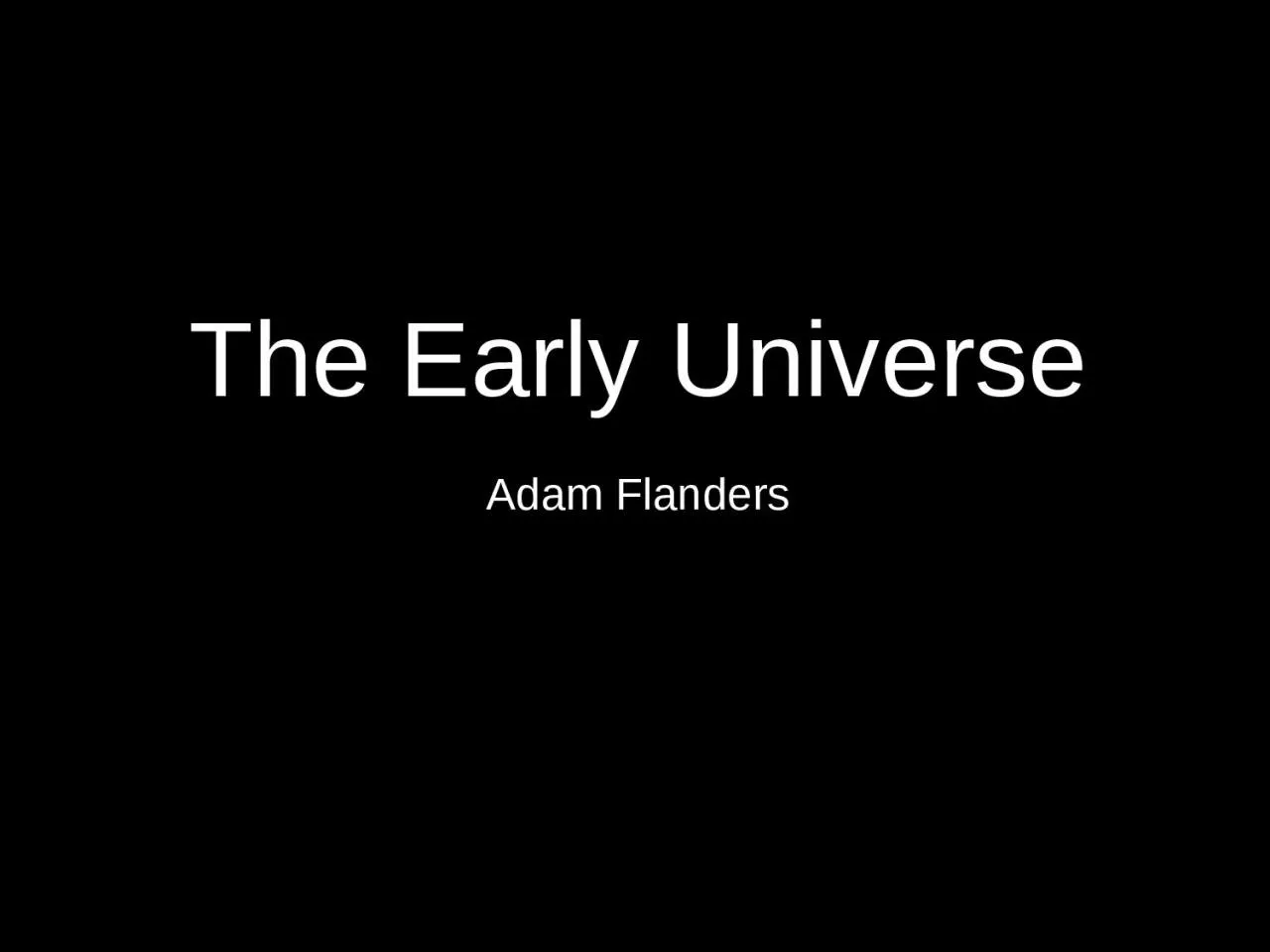

The Big Bang Currently the most accepted most supported theory for the early development of the Universe In the 1920s Edwin Hubble determined that galaxies further away from us appear to be moving away from us faster than those that are closer ID: 1026233
Download Presentation The PPT/PDF document "The Early Universe Adam Flanders" is the property of its rightful owner. Permission is granted to download and print the materials on this web site for personal, non-commercial use only, and to display it on your personal computer provided you do not modify the materials and that you retain all copyright notices contained in the materials. By downloading content from our website, you accept the terms of this agreement.
1. The Early UniverseAdam Flanders
2. The Big BangCurrently the most accepted, most supported theory for the early development of the UniverseIn the 1920s, Edwin Hubble determined that galaxies further away from us appear to be moving away from us faster than those that are closerIn 1931, Georges Lemaitre presented a theory of the “primeval atom,” which theorized that since everything appeared to be moving away, there must have been a time at which everything was much closer together.2
3. The Big BangThe name “Big Bang” was coined by Fred Hoyle during an interview in 1949After WWII, there were two theories about the “origin” of the Universe; the Big Bang theory and the Steady State theoryThe Big Bang theory gained general acceptance as more and more evidence was found for itLast nail in the Steady State theory's coffin was when the CMB radiation was discovered and confirmed3
4. Timeline of the Big Bang*GUT = Grand Unified Theory4EpochFrom t = To t =Planck0 s10-43 sGUT*10-43 s10-35 sQuark10-35 s10-4 sLepton10-4 s10-2 sNuclear10-2 s5x104 yrAtomic5x104 yr2x108 yrGalactic2x108 yr3x109 yrStellar3x109 yr?
5. Epochs in chronological orderPlanck Epoch: Little is known of the Planck Epoch, as most known laws of physics break down this close to the Big Bang. It is believed that all four fundamental forces – Gravity, Electromagnetic, Strong Nuclear and Weak Nuclear – are unified as one force during this periodGUT Epoch: The gravitational force separates from the other three forces as the universe expands and cools. Near the end of the epoch, the Strong Nuclear force and the Electroweak force (electromagnetic and weak nuclear forces combined) separate5
6. Epochs continuedQuark Epoch: Universe undergoes an incredibly rapid expansion in size, referred to as “inflation.” This inflation “smoothed out” the Universe allowing for the virtually uniform appearance of the CMB todayLepton Epoch: Particles and anti-particles, created shortly after the Big Bang, annihilate each other. Most of the anti-particles are destroyed, due to annihilation or instability, allowing normal particles to become dominant in the UniverseNuclear Epoch: Deuterium (heavy Hydrogen) and Helium begin to form by fusion during this epoch6
7. Epochs continuedAtomic Epoch: Atoms begin to form in this epoch, as the electroweak force splits into the electromagnetic force and the weak nuclear forceGalactic Epoch: Large, primordial galaxies begin to form. The first stars – much shorter lived, and likely hotter, than most stars today – form, as do the first quasarsStellar Epoch: The first stars die in violent supernova, creating more elements. Smaller, cooler stars (such as the Sun) begin to form, and even smaller objects – planets, asteroids and comets – become more abundant 7
8. Observing the Early Universe?Due to its very nature, the early Universe is very hard to actually observe directlyThere's a limit as to how far we can look back in time: the Universe was essentially opaque before the CMB was emittedPowerful telescopes (such as Hubble) are able to see back billions of yearsThree examples of such from Hubble:- Hubble Deep Field, 1995 (HDF)- Hubble Ultra Deep Field, 2004 (HUDF)- Hubble eXtreme Deep Field, 2012 (XDF) 8
9. Observing the Early Universe?The most recent of Hubble's Deep Fields is the eXtreme Deep Field, XDFOver two million seconds of exposure timeAn area “a small fraction of the angular diameter of the Full Moon”Over 5500 galaxies, faintest less than one ten-billionth of human eye visibility9
10. Hubble Deep Field10
11. Hubble Ultra Deep Field11
12. Hubble eXtreme Deep Field12
13. Sources[1] University of Oregon. 2011. The Early Universe. Eugene, OR: University of Oregon Physics Department. http://physics.uoregon.edu/~jimbrau/astr123/Notes/Chapter27.html[2] Sean Carroll. 2008. Cosmology Primer. California Institute of Technology Physics Department.http://preposterousuniverse.com/writings/cosmologyprimer/index.html[3] E. Komatsu et al. Five-Year Microwave Anisotropy Prove (WMAP) Observations: Cosmological Interpretation. astro-phhttp://arxiv.org/abs/0803.0547[4] NASA. 2010. WMAP's Introduction to Cosmology. National Aeronautics and Space Administration. http://map.gsfc.nasa.gov/universe/[5] Hawking S. 1988. A Brief History of Time. New York, NY: Random House. 248 pp.[6] Hawking S. 2001. The Universe in a Nutshell. New York, NY: Random House. 215 pp.13